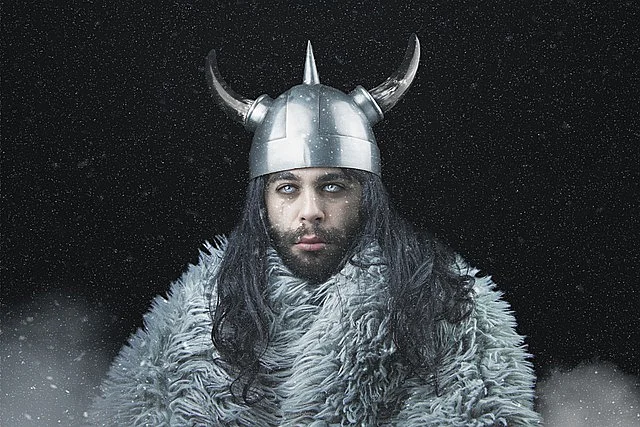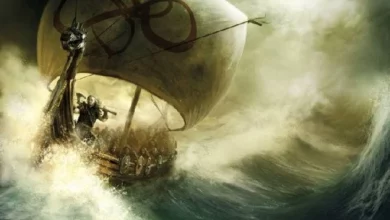What were the Vikings most afraid of, what held half the world in fear?

Vikings, the Scandinavian tribes who, on their ships, discovered new lands and terrified the fleets of medieval states. They were among the first to reach the shores of America, settled the harsh lands of Greenland and Iceland, and made an invaluable contribution to the formation of the Slavic principalities and Kievan Rus. Legends glorify the strength, courage, and fearlessness of the Vikings. But was it really like this? And if not, whom or what were the Scandinavian warriors most afraid of?
This stone with carved symbols on it is in the Swedish municipality of Edesheg in the county (administrative area) of Östergötland, south of Stockholm. The uniqueness of this artifact is that the Rökstenen stone has the longest known inscription, which consists of 762 characters – runes.
Scientists know with certainty who created the Rivers Runic Stone. The author of the inscriptions on the artifact was a Scandinavian runic master Varin. He made the inscriptions around 800-820 A.D. in memory of his deceased son. The stone was discovered in the 19th century in a church wall in the village of Rek. The weight of the granite block is about five tons, and the runes have been applied by the master on its five sides. Until recently, scientists were unable to decipher most of the symbols.
Misinterpretation of runic signs
After the discovery of the runic stone from Rek, scientists began to study this artifact. For a long time, researchers thought that the granite block referred to the name of Theodoric the Great, the legendary king of the Ostrogoths who lived in 454-526. This powerful monarch was able to unite into one state most of the territories of the Balkans and the Iberian Peninsula, as well as Italy, including the island of Sicily.
This conclusion was reached by scholars after it was suggested that Varin himself considered himself a direct descendant of King Theodoric. Consequently, the craftsman may well have created an artifact in honor of his illustrious ancestor. However, in 2007 Bo Ralfe, a respected linguistic scholar, stated that the interpretation of the name “Theodoric” in the runic text was, in fact, erroneous.

Researchers decided to thoroughly review the runic inscriptions on the Rek Stone, and entirely new versions of their deciphering began to appear immediately. So, for example, one of the fragments of text, which scientists previously considered a description of the heroic battles of past years, now proposed to interpret as a description of the process of carving the runes themselves on the stone.
Cold Ragnarök
The authors of the most recent study of the Rek Stone believe that this text fragment, in fact, tells about the supposedly imminent harsh winter, in which a battle between “light and darkness, heat and cold, life and death” is to take place. It is striking that this text echoes the descriptions of the Scandinavian end of the world, Ragnarök, in its meaning.
According to Per Holmberg, professor of Swedish at Göteborg University, the head and lead author of the research, it was impossible to decipher the runic inscriptions on the Rek stone using only a narrow approach. The scientists, however, relying on the joint work of textual analysis specialists, archaeologists, historians, theologians, and rune experts, were able, according to Holmberg, to decipher the symbols on the Rek Stone completely and authentically.
Volcanic Winter
According to Professor Per Holmberg and his colleagues, the runic writings on the Rek Stone describe the fear of Varin and his contemporaries of a possible imminent climatic crisis. About two and a half centuries before the artifact’s creation (536-547 A.D.), a series of major volcanic eruptions had occurred on the American continent.
Such events caused a climatic catastrophe in the entire northern hemisphere. However, the most devastating effects were on the inhabitants of the Scandinavian Peninsula. Archaeological evidence shows that a sharp and sustained cold snap caused crop failures in the region’s major crops. Following this, famine, exhaustion, and, consequently, the disease began in Scandinavia. These factors caused the death of more than half of the inhabitants of the Scandinavian Peninsula.
The memory of these tragic events was likely passed down from generation to generation in the form of folklore. Eventually, the myth of the cold end of the world, which the Scandinavians called Ragnarök, was born. Not surprisingly, even the most courageous Vikings feared such a scenario because no warrior could stand up to the forces of nature.
A group of researchers, having studied the times in which lived the author of inscriptions on the Rivers rune stone Varin, found even more evidence for fear of people of that era in front of climatic disasters. Scientists have established that during the life of the “rune scribe” there were at least three natural phenomena, which people of that time could consider as some kind of omen of something sinister and deadly.
So in the year 775, the most powerful solar storm known to scientists occurred. The sky over the entire Northern Hemisphere has become a purple-red shade. This color of the firmament might have been associated by the people of that time with blood, which was hardly interpreted as a good omen. And the Scandinavians were not mistaken. The following summer of that year was abnormally cold, dry, and with poor harvests, causing famine in the region.
Thirty-five years after these events – in the year 810 – a total eclipse of the Sun occurred. In Scandinavia, it happened just after dawn. People were deathly frightened: it seemed to them that the luminary had suddenly disappeared forever. Scientists reasonably believe that all these unusual and frightening phenomena, as well as grief for their suddenly deceased son, prompted Varin to think about the approaching “end of the world”. The master carved these thoughts into the Rek Stone.

In the history of the Scandinavian tribes, despite the fact that it seems almost completely studied, there are still several “white spots”. It would seem that after proving the facts that it was the Scandinavians who were the discoverers of the Americas long before Columbus, there are no more mysteries. However, scientists have refuted this judgment with a new finding.




